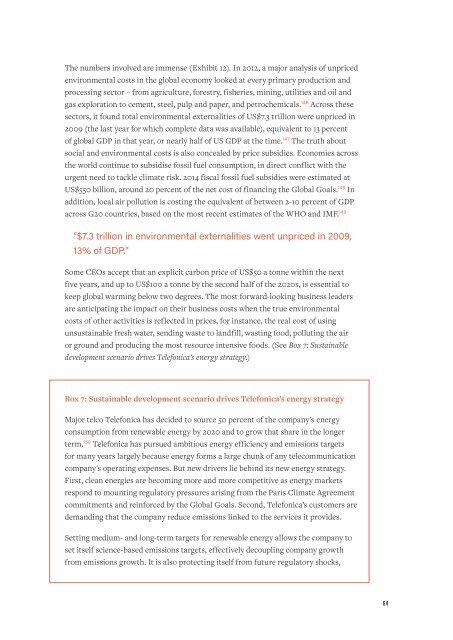BETTER BUSINESS BETTER WORLD
2jxE7K2
2jxE7K2
You also want an ePaper? Increase the reach of your titles
YUMPU automatically turns print PDFs into web optimized ePapers that Google loves.
The numbers involved are immense (Exhibit 12). In 2012, a major analysis of unpriced<br />
environmental costs in the global economy looked at every primary production and<br />
processing sector – from agriculture, forestry, fisheries, mining, utilities and oil and<br />
gas exploration to cement, steel, pulp and paper, and petrochemicals. 146 Across these<br />
sectors, it found total environmental externalities of US$7.3 trillion were unpriced in<br />
2009 (the last year for which complete data was available), equivalent to 13 percent<br />
of global GDP in that year, or nearly half of US GDP at the time. 147 The truth about<br />
social and environmental costs is also concealed by price subsidies. Economies across<br />
the world continue to subsidise fossil fuel consumption, in direct conflict with the<br />
urgent need to tackle climate risk. 2014 fiscal fossil fuel subsidies were estimated at<br />
US$550 billion, around 20 percent of the net cost of financing the Global Goals. 148 In<br />
addition, local air pollution is costing the equivalent of between 2-10 percent of GDP<br />
across G20 countries, based on the most recent estimates of the WHO and IMF. 149<br />
"$7.3 trillion in environmental externalities went unpriced in 2009,<br />
13% of GDP."<br />
Some CEOs accept that an explicit carbon price of US$50 a tonne within the next<br />
five years, and up to US$100 a tonne by the second half of the 2020s, is essential to<br />
keep global warming below two degrees. The most forward-looking business leaders<br />
are anticipating the impact on their business costs when the true environmental<br />
costs of other activities is reflected in prices, for instance, the real cost of using<br />
unsustainable fresh water, sending waste to landfill, wasting food, polluting the air<br />
or ground and producing the most resource intensive foods. (See Box 7: Sustainable<br />
development scenario drives Telefonica’s energy strategy.)<br />
Box 7: Sustainable development scenario drives Telefonica’s energy strategy<br />
Major telco Telefonica has decided to source 50 percent of the company’s energy<br />
consumption from renewable energy by 2020 and to grow that share in the longer<br />
term. 150 Telefonica has pursued ambitious energy efficiency and emissions targets<br />
for many years largely because energy forms a large chunk of any telecommunication<br />
company's operating expenses. But new drivers lie behind its new energy strategy.<br />
First, clean energies are becoming more and more competitive as energy markets<br />
respond to mounting regulatory pressures arising from the Paris Climate Agreement<br />
commitments and reinforced by the Global Goals. Second, Telefonica’s customers are<br />
demanding that the company reduce emissions linked to the services it provides.<br />
Setting medium- and long-term targets for renewable energy allows the company to<br />
set itself science-based emissions targets, effectively decoupling company growth<br />
from emissions growth. It is also protecting itself from future regulatory shocks,<br />
64


